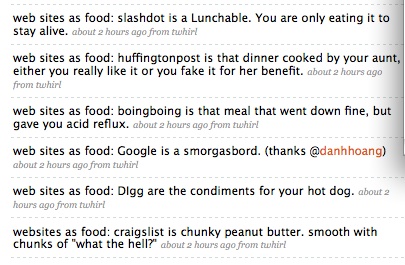I have deliberated this post to death, wanting to ensure that I made a positive contribution to the discussion of social network sites (SNS). As an educator, my use of SNS is always from a professional perspective (yeah, right), wanting to investigate different tools for language learning and teaching. 😉
During one of the umpteenth revisions to my chapter on Twitter and teaching Italian, I came across a series of articles on identity, community and SNS. danah boyd, sorry Dr. danah boyd, has been very instrumental in much of the research on community and SNS and from her and co-author Nicole Ellison, I give you the history of SNS. If you haven’t seen this, it is the intro to a volume available online.

Can you pinpoint your introduction to SNS ?
I must admit that I am a late adopter of SNS, joining this wave of new technology at the personal level only in late 2006. I deliberated very briefly introducing Facebook to the classroom, but there was too much happening on Facebook and I think it was more a personal reluctance bring it to my language students…I couldn’t focus on a single community with its multiple apps (really so many fun things happening—invites, “poking” and updates). I do know some teachers who have incorporated Facebook to their classroom as a learning management system. If you are an educator but are not yet a member of http://www.classroom20.com/ I would strongly urge you to join and read the forums available there for Facebook (and other SNS) and share your own thoughts.
Next, I joined Twitter…and I discovered I could tweet with people around the world. Immediately I knew that I had to integrate Twitter into my Italian language curriculum. How could it not be successful?
ONE: an overarching question: What are you doing?
TWO: a limited message size: 140 characters.
THREE: people would read my tweet if they saw it…it is really hard to ignore tweets if you are using Twitter when others’ tweets appear.
Then, finally, FOUR: I could communicate with people I don’t know. OK, there’s a FIVE: just because I wanted to communicate directly with someone doesn’t mean that twitterer will reciprocate (but that didn’t discourage me, eventually some did answer me and I have made many virtual connections!).
Bringing Twitter to students has not been an easy task—initially, students are a bit reluctant to join this community because, after all, they are “being graded on it” and perhaps it should be an “extra-credit” component. They also think it is too much work for a language requirement course (“I just need to get my credits to graduate”).
However, for the most part, college students generally like it once they are comfortable with what it accomplishes in terms of connections and the building of a community outside the classroom. And they tweet—one student this semester tweeted 400% more than expected (245 vs. 52 tweets required) over the 13 weeks of the course. This student has also made connections with Italian twitterers in Italy (beyond the 4 introduced to her in the class community) and it seems like she’ll be tweeting in the future.
What’s next? Well, my head is spinning…there are so many Web 2.0 tools (just look at http://www.go2web20.net/) that I really have to think through what I’d like to accomplish next and how best to achieve my goals. I’m going to be looking at some other investigations conducted by language colleagues and use that as a model.
So I ask you to share with me:
- What was the first SNS you used personally? in your classroom?
- What would you like to investigate that you haven’t yet?
Your comments would be invaluable not only to me but to many others. I would be more than happy to share what I have done with anyone who asks and hope you would do the same.






